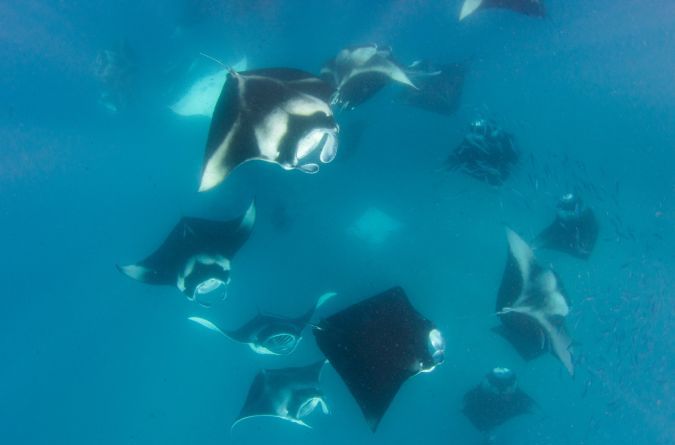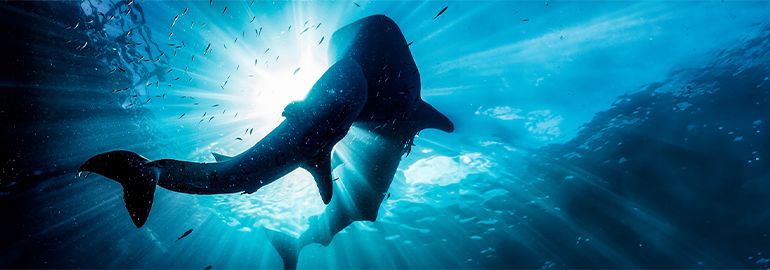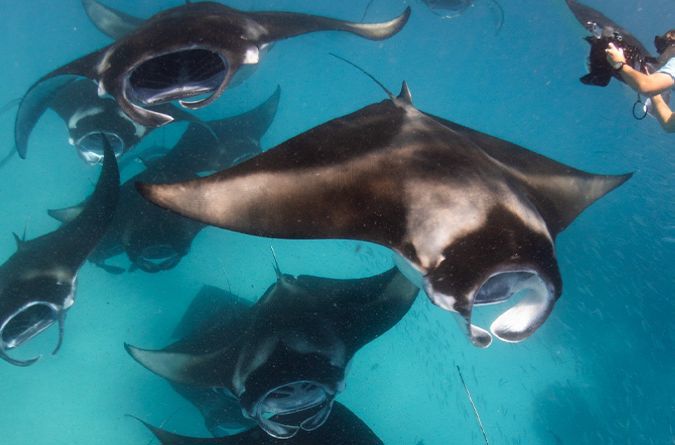About Hanifaru Bay
Hanifaru Bay, nestled within the Baa Atoll of the Maldives, is a marine marvel and a sanctuary of biodiversity. Renowned as one of the world's most significant feeding grounds for manta rays and whale sharks, Hanifaru Bay has garnered global recognition for its unparalleled underwater spectacle. This pristine marine habitat, encompassed by the protective embrace of a UNESCO Biosphere Reserve, is a testament to nature's grandeur and serves as a crucial habitat for a diverse array of marine life. From majestic manta rays gracefully gliding through the crystal-clear waters to the gentle giants of the ocean, the whale sharks, Hanifaru Bay offers a once-in-a-lifetime opportunity for visitors to witness the awe-inspiring beauty of marine life in its natural habitat. With its rich biodiversity and captivating underwater scenery, Hanifaru Bay stands as a testament to the importance of conservation efforts and serves as an emblem of the Maldives' commitment to preserving its natural heritage for generations to come.
Hanifaru Season
Main Hanifaru Season for Maldives is from May till October - all Manta Madness itineraries include Hanifaru Bay as extra option
Hanifaru Bay Information
10 fascinating facts about Hanifaru Bay:
1. UNESCO Biosphere Reserve:
Hanifaru Bay is located within the Baa Atoll Biosphere Reserve, designated by UNESCO in 2011. This recognition highlights the area's importance for marine conservation and sustainable development.
2. Manta Ray Hotspot:
Hanifaru Bay is renowned as one of the world's premier gathering spots for manta rays. During the southwest monsoon season (May to November), large numbers of these graceful creatures congregate here to feed on plankton.
3. Whale Shark Aggregation:
In addition to manta rays, Hanifaru Bay is also frequented by whale sharks, especially during the same southwest monsoon season. These gentle giants visit the bay to feed on plankton-rich waters.
4. Marine Protected Area:
Hanifaru Bay is a designated Marine Protected Area (MPA) where strict regulations are enforced to protect its fragile ecosystem. These measures aim to minimize human impact and preserve the bay's biodiversity.
5. No Anchor Zone:
To minimize damage to the coral reefs and marine life, anchoring is prohibited within Hanifaru Bay. Instead, boats use mooring buoys or drift gently in the current to observe the marine spectacle.
6. Restricted Access:
Due to its ecological significance and sensitivity, access to Hanifaru Bay is strictly regulated. Only licensed guides and a limited number of visitors are permitted to enter the bay at any given time.
7. Seasonal Variation:
The marine life activity in Hanifaru Bay is highly seasonal, with the most significant gatherings of manta rays and whale sharks occurring during the southwest monsoon season. However, sightings can also occur during the northeast monsoon season.
8. Snorkeling Paradise:
Snorkeling in Hanifaru Bay offers visitors a unique opportunity to witness the underwater ballet of manta rays and whale sharks. The shallow waters and clear visibility make it an ideal spot for snorkelers of all levels.
9. Ecotourism Destination:
Hanifaru Bay has become a popular destination for eco-conscious travelers seeking responsible and sustainable tourism experiences. Visitors are encouraged to adhere to strict guidelines to minimize their impact on the delicate marine ecosystem.
10. Conservation Efforts:
Conservation organizations and local authorities actively monitor and protect Hanifaru Bay's marine life. Research initiatives, community engagement programs, and enforcement efforts contribute to the bay's ongoing preservation and sustainability.
Guide on how to snorkel with Manta Rays and Whale Sharks:
1. Listen to the Briefing:
Pay close attention to the pre-snorkeling briefing provided by your guide. They will outline safety guidelines, snorkeling techniques, and etiquette for observing marine life without disturbing them.
2. Stay Calm and Relaxed:
Approach manta rays and whale sharks calmly and avoid making sudden movements or loud noises that could startle them. Maintain a relaxed and steady pace while swimming alongside these gentle giants.
3. Keep a Respectful Distance:
Maintain a respectful distance from manta rays and whale sharks to avoid crowding or causing distress. Adhere to any guidelines provided by your guide regarding the recommended distance to observe from.
4. Observe from Above:
When snorkeling with manta rays, position yourself slightly above them to get a better view of their graceful movements. Avoid touching or chasing after them, as this can disrupt their natural behavior.
5. Swim Alongside:
With whale sharks, swim parallel to their path rather than approaching head-on. This allows you to observe them from a safe distance while minimizing disturbance.
6. Capture Memories Responsibly:
Take photos or videos of manta rays and whale sharks to commemorate your experience but do so responsibly. Avoid using flash photography or getting too close, as this can startle the marine life or harm their sensitive eyes.
By following these guidelines, you can enjoy a safe, respectful, and unforgettable snorkeling experience with manta rays and whale sharks while minimizing your impact on their natural habitat.



